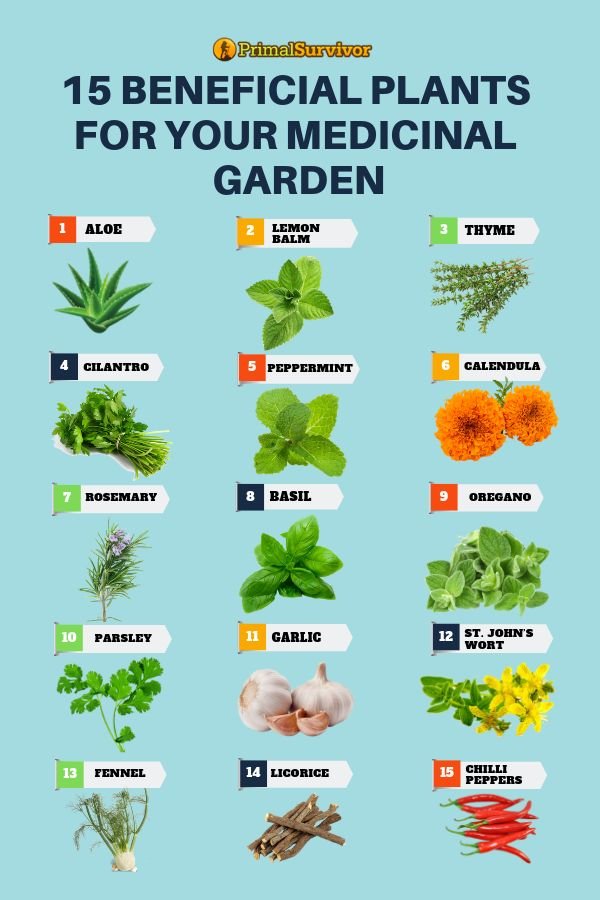In today’s world, where many people are turning to natural remedies, growing medicinal plants at home has become an increasingly popular and effective way to boost health. Medicinal plants to grow at home offer an organic, easy, and cost-effective solution for treating common ailments without relying on pharmaceutical drugs. These plants not only enhance your garden’s beauty but can also provide you with fresh, natural remedies right at your fingertips.
With the right knowledge, you can grow a variety of medicinal plants in your backyard or even indoors. Many of these plants have been used for centuries for their healing properties, and now, they’re more accessible than ever. In this article, we will explore 10 medicinal plants to grow at home, each of which offers a variety of health benefits. Whether you are looking to reduce inflammation, relieve pain, or improve your digestion, these plants are a perfect addition to your wellness routine.
Table of Contents:
- Aloe Vera – Your Go-To Plant for Skin Healing
- Lavender – Calm Your Mind with Relaxing Aromatherapy
- Peppermint – Refresh and Aid Digestion Naturally
- Chamomile – Sleep Better with This Soothing Herb
- Echinacea – Strengthen Your Immune System
- Ginger – Relieve Nausea and Reduce Inflammation
- Turmeric – Natural Anti-Inflammatory Powerhouse
- Thyme – Fight Colds and Respiratory Infections
- Lemon Balm – Relieve Stress and Promote Calmness
- Rosemary – Boost Memory and Circulatioa.

1. Aloe Vera – Your Go-To Plant for Skin Healing
Aloe Vera is one of the most well-known medicinal plants, offering multiple benefits. It’s widely used for its ability to heal cuts, burns, and skin irritations. Aloe vera gel, which can be extracted directly from the leaves, has soothing properties and acts as a natural anti-inflammatory agent.
Benefits:
- Heals sunburn and minor burns
- Moisturizes and rejuvenates the skin
- Soothes skin irritation and redness
How to Grow:
2. Lavender – Calm Your Mind with Relaxing Aromatherapy
Lavender is known for its calming scent and is often used in aromatherapy to reduce anxiety, stress, and improve sleep. It can also be used in teas and oils for additional health benefits.
Benefits:
- Reduces anxiety and stress
- Promotes relaxation and better sleep
- Eases headaches and migraines
How to Grow:
Plant lavender in a sunny spot with good drainage. It thrives in dry soil and doesn’t require frequent watering, making it easy to care for.
3. Peppermint – Refresh and Aid Digestion Naturally
Peppermint is a versatile herb known for its soothing effects on the digestive system. It can help relieve indigestion, bloating, and nausea. Peppermint tea is especially popular for calming upset stomachs.
Benefits:
- Soothes digestive issues
- Eases headaches
- Relieves muscle pain when applied topically
How to Grow:
4. Chamomile – Sleep Better with This Soothing Herb
Chamomile is best known for its calming properties, particularly when consumed as a tea before bedtime. It can help relieve insomnia, anxiety, and promote relaxation.
Benefits:
- Promotes better sleep
- Eases digestive discomfort
- Reduces stress and anxiety
How to Grow:
Chamomile thrives in full sunlight with well-drained, sandy soil. It’s a low-maintenance plant that can be grown in containers or directly in the ground.
5. Echinacea – Strengthen Your Immune System
Echinacea is widely regarded for its ability to enhance immune function and help combat colds and infections. Regular consumption of Echinacea tea or supplements can help prevent illness and reduce the duration of symptoms.
Benefits:
- Boosts immune system health
- Reduces the severity of cold symptoms
- Fights infections naturally
How to Grow:
Echinacea plants prefer full sun and well-drained soil. They are relatively hardy and can withstand various environmental conditions.
6. Ginger – Relieve Nausea and Reduce Inflammation
Ginger is an incredibly versatile root with anti-inflammatory and anti-nausea properties. It can be used in teas, smoothies, and culinary dishes to provide relief from nausea, motion sickness, and joint pain.
Benefits:
- Eases nausea and motion sickness
- Reduces inflammation
- Supports digestive health
How to Grow:
Ginger requires a warm climate and moist, well-drained soil. You can grow ginger in containers indoors or in the ground if you live in a warmer area.
7. Turmeric – Natural Anti-Inflammatory Powerhouse
Turmeric is known for its powerful anti-inflammatory properties, thanks to curcumin, its active compound. It can be used in teas, smoothies, or as a spice in cooking.
Benefits:
- Reduces inflammation
- Boosts brain function
- Supports joint health
How to Grow:
8. Thyme – Fight Colds and Respiratory Infections
Thyme is a strong herb with antimicrobial properties that help fight colds, coughs, and respiratory infections. It can also support digestion and improve immunity.
Benefits:
- Treats respiratory issues
- Reduces cough and congestion
- Supports digestive health
How to Grow:
9. Lemon Balm – Relieve Stress and Promote Calmness
Lemon balm is part of the mint family and is known for its calming properties. It is often used to relieve stress, anxiety, and digestive issues, and it has a refreshing lemon scent.
Benefits:
- Reduces stress and anxiety
- Helps with indigestion
- Improves sleep quality
How to Grow:
10. Rosemary – Boost Memory and Circulation
Benefits:
- Improves memory and cognitive function
- Enhances circulation
- Reduces muscle pain
How to Grow:
Conclusion:

Incorporating medicinal plants to grow at home into your garden or home setup is a great way to improve your overall health naturally. Whether you need a solution for digestive issues, stress, or inflammation, these plants provide a range of benefits that can be easily accessed without the use of chemicals. Growing these plants at home allows you to take charge of your wellness, and with the proper care, you can enjoy the many healing properties they offer all year round.
By adding these 10 medicinal plants to your home garden, you not only promote your health but also embrace a more sustainable lifestyle. Ready to start your medicinal plant garden? Begin today and enjoy the benefits of natural healing right at your fingertips!
10 Medicinal Plants to Grow at Home for Natural Healing Benefits
In the quest for natural healing, growing medicinal plants at home is a simple yet powerful way to incorporate holistic remedies into your life. Medicinal plants to grow at home provide not only natural treatments for common ailments but also a way to reconnect with nature. Having access to these healing plants right at your doorstep can reduce dependency on pharmaceutical products, offer fresh ingredients for homemade remedies, and even elevate your home garden’s beauty.
1. Aloe Vera – The Ultimate Skin Healer
Aloe Vera is one of the most renowned plants in the world of natural medicine, mainly for its skin healing properties. The gel inside its leaves is a powerhouse for soothing sunburns, treating minor cuts and burns, and promoting skin hydration.
Benefits:
- Heals burns, cuts, and wounds.
- Moisturizes dry skin.
- Alleviates eczema, psoriasis, and other skin conditions.
- Acts as an anti-inflammatory.
How to Grow:
2. Lavender – A Natural Stress Reliever
Lavender is known for its relaxing scent and is widely used in aromatherapy to calm the mind and promote restful sleep. It also has antiseptic properties that help treat minor burns, insect bites, and skin irritations.
Benefits:
- Reduces anxiety, stress, and depression.
- Promotes better sleep.
- Eases headaches and migraines.
- Heals skin wounds and irritations.
How to Grow:
3. Peppermint – Digestive Aid and Energy Booster
Peppermint is an incredibly versatile herb with a cool, refreshing aroma. It’s great for relieving digestive issues such as bloating, indigestion, and nausea. When applied topically, peppermint oil can also help reduce muscle tension and headaches.
Benefits:
- Eases digestive problems, including nausea and indigestion.
- Reduces headaches and migraines.
- Relieves muscle pain.
- Boosts energy levels.
How to Grow:
Peppermint grows quickly in moist, well-drained soil. It prefers partial shade but can thrive in full sunlight too. Due to its spreading nature, it’s best grown in containers to prevent it from taking over your garden.
4. Chamomile – The Calming Sleep Herb
Chamomile is a gentle herb known for its calming properties, often consumed as tea to promote relaxation and improve sleep quality. It also has anti-inflammatory properties that help soothe skin irritations.
Benefits:
- Promotes restful sleep.
- Reduces anxiety and stress.
- Eases digestive discomfort, including bloating and indigestion.
- Helps reduce inflammation and skin irritation.
How to Grow:
Chamomile is easy to grow and thrives in full sunlight with well-draining, sandy soil. It’s best to harvest the flowers in the morning when the buds are fully open. Plant chamomile in containers or directly in the ground.
5. Echinacea – Immunity Booster
Echinacea is a popular herb known for its immune-boosting properties. It’s frequently used to help prevent and reduce the symptoms of the common cold, flu, and upper respiratory infections.
Benefits:
- Enhances the immune system.
- Helps fight infections and reduce the severity of cold symptoms.
- Reduces inflammation.
- Improves overall health and vitality.
How to Grow:
Echinacea plants thrive in full sunlight and well-draining soil. They’re drought-tolerant and don’t need much care once established, making them perfect for both beginners and experienced gardeners.
6. Ginger – Nausea Relief and Anti-inflammatory
Ginger has long been used to relieve nausea, improve digestion, and reduce inflammation. It’s also known to alleviate symptoms of motion sickness, morning sickness, and digestive discomfort.
Benefits:
- Relieves nausea and vomiting, especially during pregnancy.
- Reduces inflammation and pain.
- Supports digestion and reduces bloating.
- Strengthens the immune system.
How to Grow:
Ginger grows well in warm, tropical climates. If you’re growing it indoors, place it in a pot with moist, well-draining soil. Ginger requires indirect sunlight and should be kept warm for optimal growth.
7. Turmeric – The Anti-inflammatory Powerhouse
Turmeric is a well-known spice famous for its anti-inflammatory properties, thanks to its active ingredient, curcumin. It’s used to alleviate joint pain, reduce inflammation, and promote brain health.
Benefits:
- Reduces inflammation and joint pain.
- Improves brain function.
- Promotes heart health.
- Supports digestive health.
How to Grow:
Turmeric thrives in tropical climates and requires well-drained, fertile soil. It’s best to plant turmeric in pots or in the ground if you live in a warm climate. It needs plenty of sunlight and warmth for optimal growth.
8. Thyme – Respiratory and Antiseptic Benefits
Thyme is a small herb with significant healing properties. It has natural antibacterial and antimicrobial effects, making it useful for treating colds, coughs, and other respiratory infections. Thyme is also known to improve digestion.
Benefits:
- Relieves respiratory issues, including coughs and congestion.
- Antibacterial and antifungal properties.
- Improves digestion and alleviates bloating.
- Reduces inflammation.
How to Grow:
Thyme grows best in full sunlight with well-draining, sandy soil. It is a hardy herb that requires minimal care once established. Thyme can be grown indoors or outdoors in containers or the garden.
9. Lemon Balm – Stress Relief and Digestion Aid
Lemon balm, a member of the mint family, has a lemony aroma and flavor. It’s known for its calming and stress-reducing effects, and it can also aid in digestion and relieve insomnia.
Benefits:
- Reduces stress and anxiety.
- Aids digestion and relieves bloating.
- Improves sleep quality.
- Relieves mild headaches.
How to Grow:
Lemon balm grows well in partial shade with moist, well-drained soil. It can be grown in pots or directly in the garden, and it tends to spread rapidly, so it’s best to contain it in a pot.
10. Rosemary – Memory and Circulation Enhancer
Rosemary is not just a delicious herb for cooking but also an effective medicinal plant. It is used to enhance memory, improve concentration, and increase circulation. It’s also helpful for reducing muscle pain.
Benefits:
- Improves memory and cognitive function.
- Boosts circulation and reduces muscle pain.
- Relieves stress and anxiety.
- Supports digestion.
How to Grow:
Rosemary grows best in full sunlight and prefers dry, well-drained soil. It’s a hardy herb that’s relatively low-maintenance once established. Rosemary can be grown indoors or outdoors in containers.




